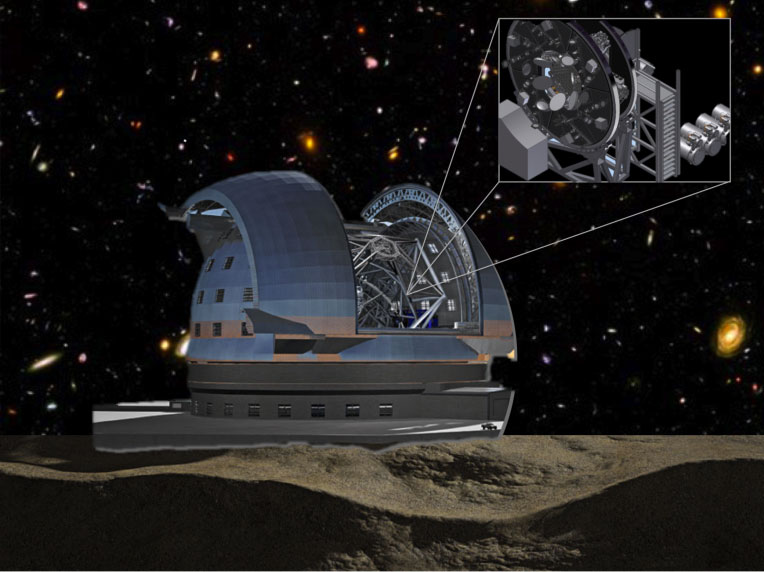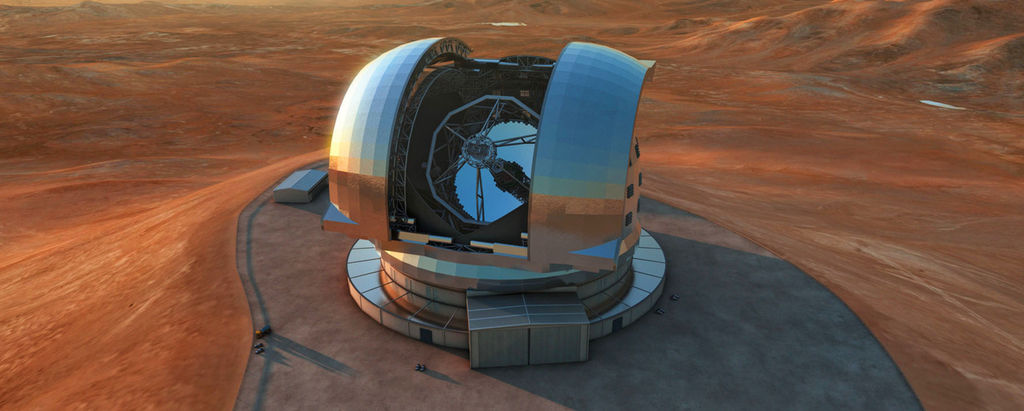|
The proposed MOSAIC multi-object spectrograph will be the workhorse instrument for the future Extremely Large Telescope (ELT), the biggest visible/infrared telescope in the world. It will be the world-leading multi-object spectrograph well into the 2020s, contributing to most fields of contemporary astronomy. Scientists from across the world are meeting in Toledo to explore the unprecedented capabilities of MOSAIC in tracking the earliest ‘first-light’ structures in the Universe, and to refine proposals for observations that will uniquely trace the amounts of dark and invisible matter in the deep Universe.
| ||
Paris, Tuesday 3rd October 2017
The MOSAIC multi-object spectrograph will be the workhorse instrument for the future Extremely Large Telescope (ELT), the biggest visible/infrared telescope in the world. It will be the world-leading multi-object spectrograph well into the 2020s, contributing to most fields of contemporary astronomy. Scientists from across the world are meeting in Toledo to explore the unprecedented capabilities of MOSAIC in tracking the earliest ‘first-light’ structures in the Universe, and to refine plans for observations that will uniquely trace the amounts of dark and invisible matter in the deep Universe (see video).
Read more: MOSAIC at the ELT: A Gigantic Step into the Deep Universe
|
| ||
17-19th October 2017 – Toledo, Spain
Scientific Rationale
|
The conceptual design of MOSAIC, a powerful multi-object spectrograph for the ELT, will conclude in late 2017. The design combines high-multiplex near-IR and visible spectroscopy, together with AO-corrected spectroscopy in the near-IR that exploits the fantastic angular resolution of the ELT across a large field of view. These capabilities will enable MOSAIC to tackle fundamental questions, e.g. pertaining to the formation and evolution of galaxies, which are simply out of reach of other facilities. This colloquium is timed to discuss the scientific opportunities of surveys with MOSAIC, focussing in particular on simulated performances from the conceptual design. It will also take stock of other developments that will influence surveys envisaged for the late 2020s. Visit website : https://www.mosaictoledo.org/ | ||
Read more: Spectroscopic Surveys with the ELT: A gigantic step into the deep Universe
On March 18, 2016, during the MOSAIC kick-off meeting at the Paris Observatory in the presence of the team(*) led by François Hammer, The European Southern Observatory has signed a phase A study contract with the MOSAIC consortium. The multi-object spectrograph will be the workhorse instrument for the ELT, being the biggest telescope in the world with its 39m diameter primary mirror. | ||
 MOSAIC will be the world-leading MOS facility, contributing to all fields of contemporary astronomy, from extra-solar planets, to the study of the halo of the Milky Way and its satellites, and from resolved stellar populations in nearby galaxies out to observations of the earliest ‘first-light’ structures in the Universe.
MOSAIC will be the world-leading MOS facility, contributing to all fields of contemporary astronomy, from extra-solar planets, to the study of the halo of the Milky Way and its satellites, and from resolved stellar populations in nearby galaxies out to observations of the earliest ‘first-light’ structures in the Universe.
The ESO contract has been signed by the CNRS-INSU (Leading Institute of the MOSAIC Consortium). The Consortium includes five Leading Countries
- France,
- United Kingdom,
- The Netherlands,
- Brazil,
- Germany,
and six Associated Partners
- Austria,
- Finland,
- Italy,
- Portugal,
- Spain,
- Sweden
Read more: MOSAIC, the Multi-Object Spectrograph of the Extremely Large Telescope (ELT)




 The Extremely Large Telescope (ELT) will be the world's largest optical/IR facility for at least a generation. It will have an immense collecting area, equivalent to gathering together all the current large telescopes in use today. Multi-object spectroscopy will be a key capability of the observatory, immediately able to harness its unprecedented sensitivity to deliver unique surveys which address a broad range of important topics in contemporary astrophysics.
The Extremely Large Telescope (ELT) will be the world's largest optical/IR facility for at least a generation. It will have an immense collecting area, equivalent to gathering together all the current large telescopes in use today. Multi-object spectroscopy will be a key capability of the observatory, immediately able to harness its unprecedented sensitivity to deliver unique surveys which address a broad range of important topics in contemporary astrophysics.